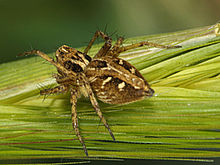Oxyopes heterophthalmus
| Oxyopes heterophthalmus | |
|---|---|

| |
| Scientific classification | |
| Domain: | Eukaryota |
| Kingdom: | Animalia |
| Phylum: | Arthropoda |
| Subphylum: | Chelicerata |
| Class: | Arachnida |
| Order: | Araneae |
| Infraorder: | Araneomorphae |
| Family: | Oxyopidae |
| Genus: | Oxyopes |
| Species: | O. heterophthalmus
|
| Binomial name | |
| Oxyopes heterophthalmus | |
| Synonyms[1] | |
| |
Oxyopes heterophthalmus is a lynx spider from the family Oxyopidae, it is the type species of the genus Oxyopes and was described by Pierre André Latreille in 1804, it has a Palearctic distribution.[1]
Description
The palps of the male have a dorsally directed patellar apophysis, which is nearly as long as male's palpal tibia. The epigyne has a reddish-brown median part, and is broadly rounded anteriorly. The body colour is dark brown, with a whitish pattern on the dorsum. The legs are black, with bright hairs and strikingly robust spines. Both sexes are 5–7 millimetres (1⁄5–3⁄10 in) in length.[2] Their abdomen is roughly triangular in shape and ends in a point.[3]
Biology
Oxyopes heterophthalmus is a long legged, diurnal[2] hunting spider which is capable of running very fast and jumping on their prey in a similar fashion to a cat, leading to their common name of lynx spider. They do not utilise webs to catch prey. Their eyesight is not as good as that of the jumping spiders but they can see their prey from a distance of up to 10 centimetres (4 in).[3] In Great Britain adults occur in late May and June.[4] The female spins a cocoon which is attached to a plant, she guards this until the eggs hatch.[3]
Habitat
Oxyopes heterophthalmus is normally found in mature dry heathland.[4] It has a preference for heather and other low shrubs.[5]
Distribution
Oxyopes heterophthalmus has a Palearctic distribution.[1] In Europe it is found in Central and Southern Europe, and is more common to the south.[5] In Great Britain it is confined to a few sites in southern England.[4]
References
- ^ a b c d "Oxyopes heterophthalmus (Latreille, 1804)". World Spider Catalog. Natural History Museum Bern. Retrieved 1 October 2016.
- ^ a b "Oxyopes heterophthalmus (Latreille, 1804)". Nentwig W, Blick T, Gloor D, Hänggi A, Kropf C: Spiders of Europe. Retrieved 1 October 2016.
- ^ a b c "Lynx spiders Family Oxyopidae". Ed Nieuwenhuys. Retrieved 1 October 2016.
- ^ a b c "Summary for Oxyopes heterophthalmus (Araneae)". British Arachnological Society. Retrieved 1 October 2016.
- ^ a b "Oxyopes heterophthalmus (Latreille, 1804)". ArachnoPhoto. Retrieved 2016-10-01.
